|
|
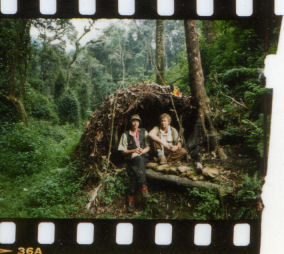  Fôret de Nyungwe (1989), by Waldo Bien Fôret de Nyungwe (1989), by Waldo Bien
At the Fôret de Nyungwe, the last remaining big Central African Jungle on the border of Rwanda Burundi, we ran into the ‘chercheurs d’or’, gold diggers. They dug deep pits in the riverbed. In the walls of the pits one could see several layers of colourful clay sediment. This aroused my interest. The rivers here were the source of the Nile. I started to collect and take clay samples, photo’s, and wrote in my notebook. This caused great suspicion among the gold diggers. They surrounded us and wanted to know what we were doing. I showed them the notebook, tried to explain them. With some mud I drew a figures on large leafs. “Ahhhhh, peintre”(painter), a very dark and tall fellow said reassured, showing his teeth.” We thought you were looking for gold”
“ We are artists, you see” I responded. “Artists do not search for gold. We make it ourselves”.
They looked at each other in astonishment. The fieldwork finally took longer than foreseen. So we were confronted with rapid advancing darkness. 6 O’clock ‘toujours’ the sun retreats within 15 minutes. Everybody is in a hurry then, rushing to his hut. Only pygmies feel comfortable in the darkness of the Jungle. They live there. Others deeply dislike it because it is full of uncanny spirits. Deepest darkness then, till 6 a.m.
I asked if we could stay overnight. He brought us to a miserable rectangular hut, separated in two by a clay wall. In the middle of the section that was appointed to us there was a smouldering fire, fed with fresh wood. A heavy smoke curtain hung throughout, hurting our eyes beyond sight. The door was kept closed to keep the smoke inside, to protect the inhabitants from mosquitoes. Laboriously it had to find its way outside, through holes and cracks in the walls and roof.
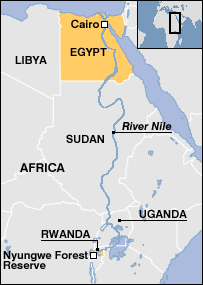 Seen from the outside it looked spooky; steaming huts in a foggy surrounding. Cold damp darkness. Jungle noise. Seen from the outside it looked spooky; steaming huts in a foggy surrounding. Cold damp darkness. Jungle noise.
A smoke curtain reached down , a foot from the ground. To find something, search a bag or someone’s feet, one had to dive below the impenetrable smoke. Doing so I discovered rats running around our feet while we were having a meal; cassava and smoked bat. They then showed us where to sleep, an improvised bed made of branches the size of a large bathing towel.
We had to share this with a giant, half- naked man who was spread out, and in a deep roaming sleep. He could not be brought to move. We tossed a coin. The honour to sleep in the middle was mine. Like a frozen soldier standing on guard I manoeuvred myself to the middle, arms pressed against my body, my nose in our hosts neck. Jacobus, my colleague and friend, took possession of the remaining space which was about the size of an ironing board. Not to fall out of bed, he had to hold with one hand onto the pole next to the bed that supported the roof. I felt like stowed cargo on a ship, pondered a while about the meaning of ‘unavoidable’.
The expected army African lice welcomed us immediately. Boring, since our positions made it impossible to scratch. Jacobus body hung half floating above the ground. Every time he fell asleep his grip loosed and he fell out of bed. Than rats started to use our stretched bodies as a racing circuit, the shortest way from wall to wall, spoiling our rest. According to our feeling this all had been going on for hours. In not too long a time the sun would rise.
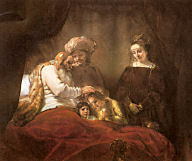 We stood up. It turned out to be 10 in the evening and bitter cold. With the help of a Rembrandt postcard, showing Jacob blessing the sons of Joseph we tried to bring the fire back to life. The rest of the night we spent in constant waving of Rembrandt but unable to get the wood to burn. The rats observed us from their holes in the clay walls, their tails left bungling outside like the pendulums of a clock. We stood up. It turned out to be 10 in the evening and bitter cold. With the help of a Rembrandt postcard, showing Jacob blessing the sons of Joseph we tried to bring the fire back to life. The rest of the night we spent in constant waving of Rembrandt but unable to get the wood to burn. The rats observed us from their holes in the clay walls, their tails left bungling outside like the pendulums of a clock.
A nearly full moon was up now and turned humid air into a mysterious milky veil, hiding the blue-black trees at the river’s side. The loud roaming of men mixed with flapping and blessing, bringing Rembrandt’s golden pallet to a sublime glow in the shimmering shine. Fast flapping opened Heaven’s gate, and warm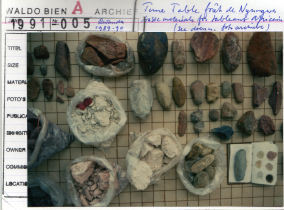 orange light would float over the postcard scene. This became the subject of our conversation. Rembrandt shows Jacob on his deathbed, his blessing hand on the head of his grandson. My friend and colleague looked like the Jacob in Rembrandt’s painting. His name also is Jacobus. On several occasions this had already lead to upheaval. orange light would float over the postcard scene. This became the subject of our conversation. Rembrandt shows Jacob on his deathbed, his blessing hand on the head of his grandson. My friend and colleague looked like the Jacob in Rembrandt’s painting. His name also is Jacobus. On several occasions this had already lead to upheaval.
Some days before, on a Sunday, after a long walk over rugged hills and forest, we’d come to an open spot, the size of a football field and surrounded by eucalyptus trees. A large crowd had gathered there to celebrate the Holy Mass that was performed by a missionary priest. To protect his balding head against sunburn, my friend had slung a light blue towel around it like Arabs do. A woman standing in the back row must have heard us forcing our way out of the bush. She slowly turned around and gazed as us, then alerted the neighbours. A minute later the complete crowd had turned on us with religious excitement, to the great annoyance of the priest. Mothers brought their children to Jacobus and wished them to be blessed. They’d recognised him from illustrations in the Holy Bible, and he did, deeply moved and with tears in his eyes.
After having discussed Rembrandts painting in all possible aspects, we concluded that the true essence is in the blessing, invisible to the eye: remembrance. Sacred mission. The transfer of knowledge onto the next generations, the only thing that really matters.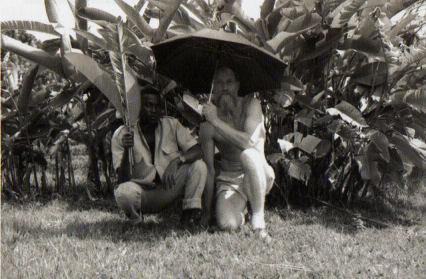
The next morning some gold diggers, hired as porters, carried the gathered rocks and clay over a rugged path to a dirt road, 12 miles or so away. Half a day and a night we’ve been sitting there, waiting at the roadside, our backs leaning against a tree, like kippered herring from all those smoky fires.
At some distance a large group of baboons had settled down on the road. They had arguments within the family. The leading male observed us in an unfriendly way. They showed interest in our luggage. We fell asleep. Woke with a shock from the noise of breaking wheels. A truck came to halt right in front of us, two foot away. It covered us with dust and an awful smell. Swarming flies, that must have been following the truck , picked on us. From the loading platform a curious crowd looked down with broad smiling faces. Blood dripped along the side of the truck, drawing a straight line of brown stains on the road. The truck carried leftovers from a nearby slaughterhouse, on its way to a market. An old French blue plastic canvas covered most of the bloody load.
About ten people had themselves installed on it, forcing everything into a mountainous blue landscape with bloody lakes, purple coastlines, darkening to red- black towards the middle. Heads and legs of cows spread over it, vegetables, and bundles with cloth. Intestines were stowed underneath. We climbed the truck with helping hands and settled down. I was surprised by the comfort of sitting on a pile soft intestines, turning the bumpy road into a gentle rolling ocean and it made me feel as if in an embryonic state.. Almost instantly I fell asleep.
|
|